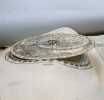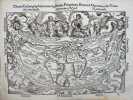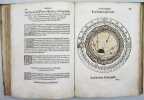3 books for « gemma frisius »Edit
-
Topics
Astronomy (1)
Medicine (1)
-
Countries
Belgium (1)
France (2)
-
Syndicate
ILAB (2)
SLAM (2)
Gemma Phrysius de Principiis astronomiae & Cosmographiae Deq3 vsu Globi ab eodem editi. Item de Orbis divisione, & insulis, rebusq3 nuper inventis. Seconde édition augmentée, de la plus grande rareté, de cet important ouvrage de cosmographie de Gemma Frisius, le fondateur de la cartographie scientifique aux Pays-Bas et le professeur de Mercator.
Précieux exemplaire de ce rare ouvrage d’astronomie et de cosmographie. In-16 de (92) ff. Pte. restauration à l’angle supérieur droit du titre. Maroquin havane, encadrement de deux filets dorés autour des plats avec fleurons d’angle, dos à nerfs orné de fleurons et de filets dorés, roulette dorée intérieure, tête dorée, témoins. Reliure du XIXe siècle. 138 x 95 mm.
Seconde édition augmentée, de la plus grande rareté, de cet important ouvrage de cosmographie de Gemma Frisius, le fondateur de la cartographie scientifique aux Pays-Bas et le professeur de Mercator.La présente édition comporte bien toutes les informations relatives à l’Amérique : les chapitres 30 et 31 traitent de l’Amérique et des iles américaines.Sabin 26855.“Chapter XXX is about Americo Vespucius, Brazil, cannibals, Darien, and Florida; chapter XXXI is on the American islands; Guiana, Cuba, Yucatan, Cozumella, and Jamaica”. « Chap XXIX, De insulis nuper inventis ; chap. XXX, De America ; chap. XXXI, De Insulis apud Americam » (Sabin, 62588, à propos de l’édition de Paris, 1548). L’ouvrage se termine sur une table des villes avec leur longitude et leur latitude.La première édition avait paru en 1530.« It seems probable that this little book was issued to serve as explanatory text for a globe or globes Gemma Frisius had constructed or was preparing to construct. In it we have one of the earliest technical yet practical explanations of the parts and uses of the globe, and of somewhat detailed statement how such instruments may be serviceably employed in cosmographical studies. On the title-page there appears the representation of a globe resting on a base having three feet, which has been thought to be a representation of his completed work. We are told in his ‘Epistola salutatoria’, at least in an implied manner, that there were to be numerous copies of the globes, seeing that they were intended for the trade, and Roscelli’s statement would lead us to believe that they had found their way into Italy […]” (Stevenson, Terrestrial and Celestial globes, p. 102).Gemma Frisius s’appelait Reinerus [Regnier]. Il nâquit à Docum en 1508 d’une famille honnête. Ce fut un Médecin profond en la théorie de son art, & heureux en la pratique. Mais il excella surtout dans les Mathématiques. Il fut extrêmement aimé & estimé par l’Empereur Charles-Quint, & même suivant l’avis de ce Prince, qui était savant en Astronomie & en Géométrie il corrigea une faute qu’il avait faite en sa Mappemonde, laquelle il dédia à cet Empereur. Il mourut à Louvain en 1555 de la peste. “He was the pupil of Apianus and teacher of the celebrated cosmographer Juan de Rojas.”Gemma Frisius (1508-1555) est un cartographe et mathématicien hollandais qui fit ses études en Belgique. Sa première œuvre est une révision du livre de cosmographie de Peter Apian ; elle attire l'attention de Jan Dantyszek. Son traité De locorum describendorum ratione est important dans l'histoire de la géodésie, car il contient le plus ancien exposé des principes de la triangulation et une méthode de détermination des longitudes. Ses contributions scientifiques ont une grande place dans le domaine de la cartographie pratique.Il ouvre un atelier dédié à la cartographie et travaille avec les graveurs Van der Heyden et Bollaert ou Graphius d'Anvers. Tycho Brahe et Kepler loueront la précision des instruments fabriqués par lui. Gemma Frisius est également un des premiers vulgarisateurs de la cosmologie.Son œuvre en a fait le chef de l'école géographique néerlandaise, dont son élève Gerardus Mercator a été le plus brillant représentant. Trois autres de ses élèves deviendront célèbres : André Vésale en anatomie, Rembert Dodoens en botanique et Johannes Stadius en astronomie.Le cratère lunaire Gemma Frisius a été nommé en son honneur.His work Gemma phrysius de principiis astronomiae & cosmographiae was translated into several languages and reprinted numerous times.He made two significant contributions to the earth sciences. In a chapter added to the 1533 Antwerp edition of the Cosmographicus, he was first to propose the principle of triangulation as a means of carefully locating places and accurately mapping areas. 20 years later, in the 1553 Antwerp edition of De princinpiis astronomiae, he was the first to suggest in explicit terms the use of portable timepieces to measure longitude by lapsed time.Kish credits Gemma as the first to suggest the use of an accurate timekeeping instrument as a solution to the problem of longitude, and as among the first to propose triangulation for surveying and mapmaking. Gemma Frisius did a world map with lines of latitude and longitude in 1540. L’édition est ornée d’une gravure sur bois représentant un globe sur le feuillet de titre et d’une sphère armillaire au f. A6v.Précieux exemplaire de ce rare ouvrage d’astronomie et de cosmographie.Nous n’avons trouvé qu’un exemplaire de cette rare édition passé sur le marché public ces quarante dernières années.
Cosmographia Petri Apiani per Gemma Frisium apud Lovanienses Medicum & Mathematicu[m] insignem, iam demum ab omnibus vindicata mendis, ac nonnullis quoque locis aucta. Additis eiusdem ar-gumenti libellis ipsius Gemmae Frisij.
Antverpiae ( Antwerpen ) , Apud haeredes Arnoldi Birckmanni, printed by Aegidius van Diest (in colophon), 1564, in-4°, 21 x 16 cm, (4)nn pp (title with large woodcut globe) + 128 pp (numbered fol.1-64) + (3)nn pp (tabella) + (1)(bl), with 45 woodcuts in the text, a double page worldmap (Shirley 96) and 4 volvelles (complete). Bound in brown coloured and blindtooled vellum, spine renewed. Nice complete copy , and with, which is very rare, the four volvelles or Apian wheels in perfect shape and absolutely complete. The only negative remark to be made for completeness sake is that the worldmap has been very slightly shaven at the top, resulting in the loss of the head of a few letters. Bound in at the end is '' Himmels lauffs wirckung und natuerliche influentz der Planeten, Gestirn und Zeychen...''. Frankfurt, 1564, haer. Christian Egenolff. (8)nn pp + 108 pp, with woodcut ills.. Unfortunately this book lacks four leaves ( Cii , Ei, Oiii and Yiiii). (USTC 663722). The first edition of Apianus' major work on astronomy , geography and cartography was published in Landshut in 1524. In 1533 was published in Antwerp a reworked edition incorporating the triangulation method developped by Gemma Frisius which opened the way to modern cartography. Indeed the first map with accurate distances was made in the Southern Low Countries based upon triangulations made by Gemma Frisius who climbed the Sint-Rombauts cathedral tower in Mechelen and started measuring the distances to Lier, Antwerpen, Gent , Brussel, Bergen op Zoom, Leuven. (Explanation on pages 51-53). USTC 404413 (Apian) .
La cosmographie ou description des quatre parties du monde.
Anvers, Jean Bellere, 1581.
Belle édition dans la traduction et les additions de Regnier Gemma ou Gemma Frisius. Elle est illustrée par de nombreux bois gravés (globes, sphères, instruments d'astronomie et d'arpentage) et une carte du monde sur double page, d'après la carte dressée par Gemma Frisius en 1540, qui est aujourd'hui perdue. 5 gravures portent des volvelles (des parties mobiles) : 2 volvelles p. 20. Une ficelle pour pointer p. 22. 3 volvelles et une ficelle p. 26. 3 volvelles p. 66. 2 volvelles p. 189. Exemplaire complet de toutes ses parties mobiles ce qui est très rare et la carte du monde est bien présente. On trouve à la fin du texte d'Apian "L'usage de l'anneau astronomique" de Gemma Frisius et aussi, du même "L'usage du globe astronomique" et le "Ray astronomique & géométrique". Brun, Le livre illustré de la Renaissance 112. /// In-4 de (8), 333 pp., 1 f. bl. Vélin. (Reliure de l'époque.) //// Fine edition in the translation and additions of Regnier Gemma or Gemma Frisius. It is illustrated with numerous woodcuts (globes, spheres, astronomical and surveying instruments). Complete of all moving parts (10 volvelles and 2 thread pointers) and the double page world map. It is based on the larger map prepared by Gemma Frisius and published in Louvain in 1540, but which has now been lost. North America is labelled 'Baccalearium' in reference to the cod fishing nearby. 5 engravings bear volvelles (moving parts): 2 volvelles p. 20. A string for pointing on p. 22. 3 volvelles and a string on p. 26. 3 volvelles on p. 66. At the end of the Apian text is "L'usage de l'anneau astronomique" by Gemma Frisius and by the same "L'usage du globe astronomique" and "Ray astronomique & géométrique". Shirley, Mapping of the world N° 96.
 Write to the booksellers
Write to the booksellers








